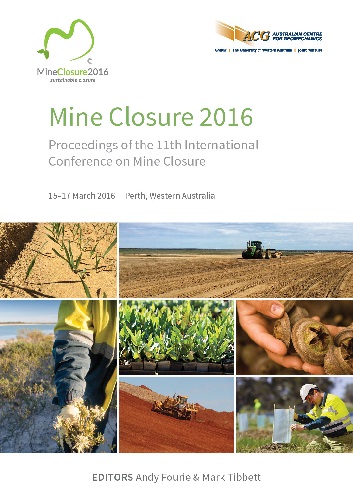The use of satellite-based remote sensing methods to assess the changes in the environmental impacts from the Marcopper disaster on Marinduque Island, Philippines

|
Authors: Dacre, CK; Mercer, KG; Smith, FGF; McParland, MA; Morin, R |
DOI https://doi.org/10.36487/ACG_rep/1608_24_Dacre
Cite As:
Dacre, CK, Mercer, KG, Smith, FGF, McParland, MA & Morin, R 2016, 'The use of satellite-based remote sensing methods to assess the changes in the environmental impacts from the Marcopper disaster on Marinduque Island, Philippines', in AB Fourie & M Tibbett (eds), Mine Closure 2016: Proceedings of the 11th International Conference on Mine Closure, Australian Centre for Geomechanics, Perth, pp. 339-352, https://doi.org/10.36487/ACG_rep/1608_24_Dacre
Abstract:
The Marcopper Mining Disaster occurred between 1975 and 1996 on the Philippine island of Marinduque, a province of the Philippines. It remains one of the largest mining disasters in history and is almost completely un rehabilitated. The Marcopper Mining Corporation mined the Mt. Tapian ore body followed afterwards by the San Antonio copper ore body, using open pit methods. Three separate environmental incidents occurred during this time which finally culminated in between 2 to 3 million tonnes of tailings which flowed from the Tapian in pit tailings facility along a drainage tunnel into the 26 km long Boac River. Flooding isolated and buried some villages under 2 m of floodwater and tailings. Environmental impacts were considerable and the government declared the Boac River dead. Since 2002, despite two major studies which were completed in 2004 and 2005, no remediation efforts have been undertaken on any of the waste landforms or rivers to date. In order to understand the ongoing environmental changes taking place on the mine waste landforms, the Australian Centre of Geomechanics partnered with MacDonald, Dettwiler and Associates to undertake a preliminary review of the Marcopper waste landforms using products derived from historical radar and optical images collected over the island from the 1996 to 2014. This paper summarises the results of this study and makes recommendations for further remote sensing studies and ground-truthing activities. Remote sensing challenges using historical data were significant and included persistent cloud cover or haze in regions, heavy vegetation in some areas, and localised steep terrain. Historical images were used to map the changes taking place on the waste landforms using a variety of remote sensing approaches including automated multi-date change detection algorithms, Normalised Difference Vegetation Index, terrain analysis and land cover mapping. This study found that the Calancan Bay tailings outfall has retreated over 550 m since 1996 and that barren and steep-sloped regions are present near the mine pits and tailings dams. In addition, the size of both pit lakes has continued to increase. Nevertheless, the findings showed that within the vicinity of the open pits and mine waste landforms there has been gradual reestablishment of vegetation during the 18-year study period.
References:
Balaba, RM 2005, ‘Repair of Marcopper's mine tailings dams urged’, Business World, 2 February 2005.
Jensen, JR 1996, Introductory digital image processing, Prentice-Hall, Inc., Upper Saddle River, NJ.
Mojares, EM, Alban, MW & Villanueva, AA 2012, Geological/Geohazard Investigation of Critical Mine Structures and Facilities of Marcopper Mines in Sta. Cruz, Marinduque, report produced by the Geosciences Division (GD) and the Mining Environment and Safety Division (MESD) of MGB Region IV-MIMAROPA, unpublished.
OXFAM Australia 2005a, Chronology of Events, Unpublished.
OXFAM Australia 2005b, Mining Ombudsman Case Report: Marinduque Island, S Lowe & L Vettori (eds), Fitzroy, Australia.
The Futures Group International 2004, Engineering, health and environmental issues related to mining on Marinduque: final report of the independent assessment team, The Futures Group International, Washington DC.
© Copyright 2025, Australian Centre for Geomechanics (ACG), The University of Western Australia. All rights reserved.
View copyright/legal information
Please direct any queries or error reports to repository-acg@uwa.edu.au
View copyright/legal information
Please direct any queries or error reports to repository-acg@uwa.edu.au